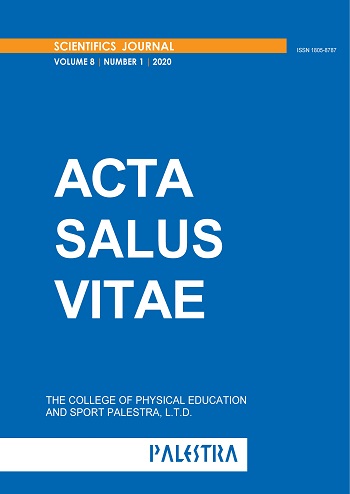Evaluation of quality of life of seniors with degenerative spinal cord disorders
DOI:
https://doi.org/10.58743/asv2020vol8no1.221Keywords:
Degenerative spinal disorders; Quality of life; Seniors; SF-36 questionnaire.Abstract
The goal of the research was to assess the quality of life of the seniors with degenerative spinal disorders. The research was conducted on 71 seniors with diagnosed degenerative spinal disorders, among them 33 women (46%) and 38 men (54%). The age of the subjects was in the range from 60 to 75 years. The questionnaire SF-36 was used to evaluate the indicators of the quality of life. The diminished quality of life was felt most strongly in the areas of general health (73%), vitality (62%) and physical activities (56%). Least affected were social activities (25%). The subjects perceived the reduced quality of life more in the physical dimension than in the mental dimension (58%). Spinal degenerative disorders had the biggest impact on the general sense of wellbeing in monitored seniors. They lowered vitality level and hampered physical activities. The least affected was the perceived quality of life in the area of social activities, and the assessment of the quality of life was independent of the subjects’ sex.
References
Aleti, H. and Motaleb, I. A. (2014) Study of stress and strain in human spine. IEEE International Conference on Electro/Information Technology, Milwaukee, pp. 184-189, doi: 10.1109/EIT.2014.6871759.
Carlson, S.A., Adams, E.K., Yang, Z., Fulton, J.E. (2018). Percentage of Deaths Associated With Inadequate Physical Activity in the United States. Preventing Chronic Disease.15(29)E38. doi: 10.5888/pcd18.170354.
Dziak, A. (2003) Bolesny krzyż. Kraków: Medicina Sportiva.
Grzegorczyk, J., Kwolek, A., Bazarnik, K., Szeliga, E., Wolan, A. (2007). Jakość życia osób mieszkających w domach pomocy społecznej i słuchaczy uniwersytetu trzeciego wieku. Przegląd Medyczny Uniwersytetu Rzeszowskiego, 3(1) 225-233.
Ignasiak Z., Janusz, A., Jarosińska, A. (2002). Anatomia człowieka. Wrocław: AWF.
Klimaszewska, K., Krajewska – Kułak, E., Kondzior, D., Kowalczuk, K., Jankowiak, B. (2011) Jakość życia pacjentów z zespołami bólowymi odcinka lędźwiowego kręgosłupa. Problemy Pielęgniarstwa, 19(2) 47-54.
Hajat, C., Stein, E. (2018). The global burden of multiple chronic conditions: A narrative review. Preventive Medicine Reports, 12: 284–293. doi: 10.1016/j.pmedr.2018.10.008
Haywood, K.M., Getchel, N. (2018). Life Span Motor development. Ed. 6. Champaign: Human Kinetics. 448 p.
Kiwerski J., Kowalski M. (1997). Schorzenia i urazy kręgosłupa. Warszawa: PZWL.
Kushchayev, S.V., Glushko, T., Jarraya, M., Schuleri, K.H., Preul, M.C., Brooks, M.L., Teytelboym, O. (2018). ABCs of the degenerative spine. Insights Imaging. 9(2):253-274. doi:10.1007/s13244-017-0584-z
Kwapisz U., Głowacka M. (2008). Samoocena zdrowia pacjentów w starszym wieku po leczeniu uzdrowiskowym w badaniach SF-36. Balneologia Polska, 15(3) 140-147.
Muszalik M., Kędziora-Kornatowska, K. (2009). Jakość życia przewlekle chorych pacjentów w starszym wieku. Gerontologia Polska 4, (2)185- 189.
Post, M. W. (2014). Definitions of quality of life: what has happened and how to move on. Topics in spinal cord injury rehabilitation, 20(3), 167–180. https://doi.org/10.1310/sci2003-167
Radziszewski K. (2008). Stan funkcjonalny pacjentów z dyskopatią kręgosłupa lędźwiowego leczonych wyłącznie zachowawczo bądź operowanych. Wiadomości Lekarskie, 61(3) 23-29.
Rehor, P. R. (2016). “Yes I Can” Exercise Adoption and Adherence Model. In: Zvonař, M., Sajdlová, Z. Proceedings of the 10th International Conference in Kinanthropology “Sport and Quality of Life”, Masaryk University, Brno, November 18-20, 2015. Brno: Faculty of Sport Studies Masaryk University. 71-81.
Rehor, P. R (2002). Connection to purpose. Australian Council for Health, Physical Education, and Recreation Healthy Lifestyles Journal, 64(2) 134 -145.
Rehor, P. R., Kornatovska, Z. (2013). Measuring of health – related benefits of physical activity in high school students. Acta Salus Vitae, 1(2), 148-157.
Sobczak, M. (2007). Statystyka. Warszawa: PWN.
Szulkowska K., Fronczek – Wojciechowska M., Pieszyński I., Adamczewski T., Kujawa J. (2011). Porównawcza ocena skuteczność przeciwbólowej wpływu prądów interferencyjnych, ultradźwięków i terapii łączonej obu metod na ograniczenie promieniowania dolegliwości bólowych u chorych z przewlekłym zespołem bólowym kręgosłupa w przebiegu choroby zwyrodnieniowej. Kwartalnik Ortopedyczny, 4(1) 436-446.
Tate, D.G., Forchheimer, M., Bombardier, CH., Heinemann, A.W., Neumann, H.D., Fann, J.R. (2015). Differences in quality of life outcomes among depressed spinal cord injury trial participants. Archives of Physical Medicine and Rehabilitation, 96(2) 340-348. doi:10.1016/j.apmr.2014.09.036
Tylka J., Piotrowicz R. (2009). Kwestionariusz oceny jakości życia SF-36. Kardiologia Polska, 67, 1166- 1169.
Downloads
Published
How to Cite
Issue
Section
License
Copyright (c) 2020 Bartosz Bolach, Eugeniusz Bolach, Marta STĘPIEŃ-SŁODKOWSKA, Zuzana Kornatovská

This work is licensed under a Creative Commons Attribution 4.0 International License.
Authors publishing in this journal agree to the following terms:
Authors retain copyright and grant the journal the right of first publication, while the work is also licensed under the Creative Commons Attribution License, which allows others to share this work acknowledging its author and initial publication in this journal.
Authors are permitted to enter into separate, additional contractual arrangements for the non-exclusive distribution of the work in the version published in the journal (for example, to publish it in a book), with an acknowledgement of its initial publication in this journal.
Authors are allowed and encouraged to share their work online (for example, on their websites) before and during the editorial process of their contribution, as such a practice can lead to productive exchanges of ideas and also earlier and higher citation of the published work (See the Open Access Effect).


